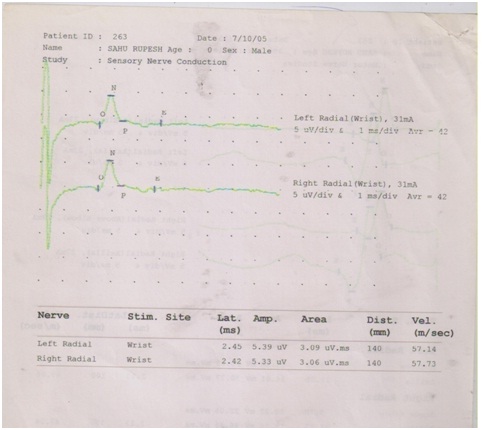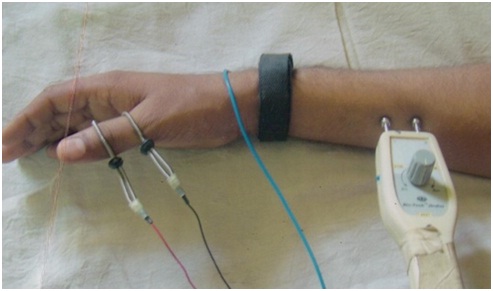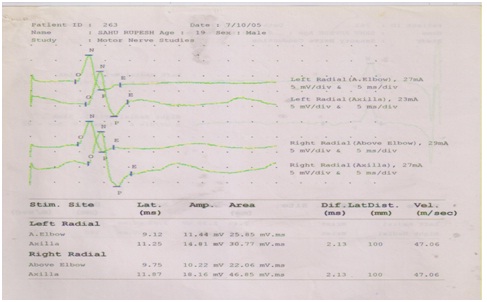Normal Motor and Sensory Nerve Conduction Velocity of Radial Nerve in Young Adult Medical Students
Sunil Chouhan1
1 Assistant Professor, Department of Physiology, All India Institute of Medical Sciences (AIIMS), Bhopal, (M.P.), India.
NAME, ADDRESS, E-MAIL ID OF THE CORRESPONDING AUTHOR: Dr. Sunil Chouhan, Assistant Professor, Department of Physiology, All India Institute of Medical Sciences (AIIMS), Bhopal-462020, (M.P.), India. E-mail : sunil.physiology@aiimsbhopal.edu.in
Introduction
Normal nerve conduction velocity of radial nerve is essential for differential diagnosis of various type of radial neuropathies, C7 radiculopathy and nerve lesion.
Aim
To study normal motor and sensory nerve conduction velocity of radial nerve in young adult medical students.
Materials and Methods
Fifty medical students of either sex from first year, aged between 17- 20 year, were recruited for this nerve conduction study of radial nerve using surface electrode. Motor Nerve Conduction Velocity (MNCV) and Sensory Nerve Conduction Velocity (SNCV) of radial nerve of both hand were taken out and analysed for statistical significance and standard deviation.
Results
The mean Motor Latency (ML) in right and left hand were 8.11 mdiv and 8.01mdiv respectively, Amplitude (A) 9.08mv and 8.65mv respectively and MNCV was 66.81m/div and 67.05m/div respectively. The SNCV were 51.41 m/div and 51.48m/div in the right and left hand respectively.
Conclusion
The normative value of motor and sensory NCV of radial nerve in male and female young medical students were established. The data were within the favourable range as compared with the existing data from other researchers for radial nerve. There were no difference statistically found in the radial nerve motor and sensory NCV of right and left hand of either sex.
Introduction
The nerve are like electrical wire through which electricity/impulse passes from one point to another point. When the impulse is transfer from nerve to muscle, motor activity of that particular muscle occur but if the nerve is damaged, the passage of impulse is affected and hence motor activity of that particular muscle is also affected. There are various conditions which affect Nerve Conduction Velocity (NCV) like age, upper and lower limb, temperature, hence there cannot be a universal one reference value of a particular nerve taking into consideration of geographical variation of climate in the world. Therefore different regions and labs have their own standard reference value. Radial nerve is a mixed nerve having motor as well sensory components, which originates from the posterior cord of the brachial plexus with root value of C5,6,7,8 and T1 [1], innervating vital muscles like triceps, extensor carpi radialis longus, etc. This nerve supplies especially extensors muscle in the forearm and arm, which also assists in the sensation in the hand/wrist. The possible radial nerve dysfunction includes any problem related to hand, wrist movement (Ex-a wrist drop is characteristic) and any abnormal sensation of the arm, which may be due to prolong nerve pressure, stretch by neighboring structures, compression injury (Saturday night palsy), or direct trauma. Also by vigorous exercise, in rare cases, radial neuropathy has been reported [2,3]. The other ways by which radial nerve can be damaged which may lead to sensory changes in the areas which it supplies are, intramuscular injection at wrong site [4,5], by tight watchband or handcuffs [6,7], benign tumour [8,9], etc. The normal value of nerve conduction velocity (NCV) of radial nerve, both motor and sensory is exigent, when analysis of radial neuropathies is done pertaining to lesion of axillary, arm, elbow and wrist region. The radial nerve motor and sensory NCV is an electro diagnostic method to evaluate and distinguish between radial neuropathy from C7 radiculopathy or plexopathy, localization of lesion by knowing affected muscles and for prognosis of the nerve lesion [10], hence normal value of NCV of radial nerve is essential for comparisons. On the same group of subjects (n=50), motor nerve conduction studies on median and peroneal nerve were conducted [11,12]. Apart from above data, motor and sensory nerve conduction velocity of ulnar nerve were also established but still the data have not been published.
Normal value of individual nerve differs from place to place and from lab to lab because NCV depend on various factors like height, temperature, age, etc., of that particular region. This is needed to differentiate diagnosis from abnormal NCV which occur in radial neuropathy, C7 radiculopathy and in posterior cord lesion.
Materials and Methods
This study was conducted in 2006 after obtaining all the necessary permission at the level of Netaji Subhash Chandra Bose (NSCB) Medical College, and Jabalpur University. The ethical clearance was taken during August 2005 before the commencement of the study. The computerized machine obtained from Neurocare -2000 was used in this study. Fifty, first years medical students aged between 17-20 year from either sex from were randomly asked to volunteered for the study and only fifty finally participated in this study. Care was taken to exclude the subjects for any underlying neurological problem after physical examination. The students were asked to withdraw from the study at any point of time, if they were not comfortable with the study.
After obtaining the written consents from the subjects, (NCV) of radial nerve, both sensory [Table/Fig-1,2] and motor [Table/Fig-3] was obtained by using surface electrode. The active electrode was put after applying jelly (for good conduction and for reduced impendence) over the extensor digitorum (easily located by asking the subject to extend his or her finger at the metocarpophalangeal joint). The reference surface electrode was put over the wrist and the ground electrode between active and stimulating electrode. The stimulation was given at two points, first at the elbow (with stimulator firmly pressed against the lateral aspect of the biceps tendon) and secondly at the spiral groove between the medial and lateral heads of the triceps muscle. The motor NCV was calculated from first and second stimulation point [Table/Fig-3]. The sensory nerve conduction velocity, SNCV (orthodromic) [Table/Fig-1,2] was done using the active ring electrode [Table/Fig-2] over the thumb, reference over the middle of the intermediate thumb 3cm distally to active electrode and ground electrode on the wrist. The radial nerve was stimulated at approximately 10 cm to the active electrode over the edge of the radius to find the Distal Latency (DL), amplitude of Sensory Nerve Action Potential (SNAP) and NCV of radial sensory nerves.
Sensory study of radial nerve showing SNAP (Sensory Nerve Action Potential).

Sensory placement of ring electrode and stimulation.

Motor study of radial nerve showing CMAP (Compound Motor Action Potential).

Statistical Analysis
The distal latency, amplitude, nerve conduction velocity of both hand were analysed and the data was presented as mean and standard deviation. The independent t-test was done for gender difference and paired t-test was used for side to side difference i.e. right and left hand. The value of p less than 0.05 was considered statistically significant.
Results
The various parameter of NCV were recorded: Motor and sensory Distal Latency (DL), Amplitude (A), Nerve Conduction Velocity (NCV) of radial nerve. The finding presented in [Table/Fig-4], of motor studies include a mean latency of in the groove above elbow was 6.58±1.95,6.46±1.89 and a mean amplitude of 8.95±3.53, 9.24±3.76 in the right and left hand respectively. There was no significant difference between the latency and amplitude of the right and left arm respectively (p>0.05). The finding in the axilla include NCV of 66.81±5.95 and 67.05±6.62 for right and left hand respectively. In [Table/Fig-5], the mean latency of sensory NCV of radial nerve are 2.65±0.33/2.58±0.21, a mean amplitude of 8.50±5.37/8.49±4.98 and a mean NCV from thumb to wrist was 51.41±6.97/51.84±7.10 for the right and left hand respectively, having no significant difference (p>0.05).
Radial nerve(Motor studies)
| Motor studies | | Latency (millisecond) | Amplitude (millivolt) | NCV (meter per second) |
|---|
| Stimulation site of Radial nerve | Parameter | Right | Left | Right | Left | Right | Left |
| Elbow | Mean | 6.58 | 6.46 | 8.95 | 9.24 | | |
| SD(±) | 1.95 | 1.89 | 3.53 | 3.76 | | |
| Significance | t=0.39;p>0.05 | t=0.40;p>0.05 | | |
| Axilla | Mean | 8.11 | 8.01 | 9.08 | 8.65 | 66.81 | 67.05 |
| SD(±) | 2.01 | 1.95 | 4.49 | 4.26 | 5.95 | 6.62 |
| Significance | t=0.25;p>0.05 | t=0.49;p>0.05 | t=0.99;p>0.05 |
Radial nerve(Sensory studies).
| Sensory studies | | Latency (millisecond) | Amplitude (millivolt) | NCV (meter per second) |
|---|
| Stimulation | Parameter | Right | Left | Right | Left | Right | Left |
| wrist | Mean | 2.65 | 2.58 | 8.50 | 8.49 | 51.41 | 51.48 |
| SD(±) | 0.33 | 0.21 | 5.37 | 4.98 | 6.97 | 7.10 |
| Significance | t=1.27;p>0.05 | t=0.01;p>0.05 | t=0.05;p>0.05 |
Correlation between height and NCV.
| Male/n=50 | Female/n=50 |
|---|
| Radial nerve | NCV_ Right | NCV_ Left | NCV_ Right | NCV_ Left |
| r | - 0.26079 | - 0.26079 | - 0.03988 | - 0.14248 |
| p | 0.0907475 | 0.103994 | 0.424942 | 0.24844 |
r=coefficient of correlation.
p=t-test for significance of correlation
The correlation coefficient of radial nerve NCV among male and female subjects was 0.26079 / 0.26079 and 0.03988 / 0.14248 for right and left hand respectively.
Discussion
The normal NCV (motor and sensory) of radial nerve of students of that region i.e. Jabalpur was taken . The study was to be conducted in the age group of 17-20 year and this group was viable in the first year of MBBS study, hence only first year student were selected for this study. The data obtained can be compared with students with different region and moreover can be compared in abnormal conduction where NCV is being altered. This study has documented normal radial nerve motor and sensory NCV for young adult’s medicals students between the age group of 17-20 year. All the subjects had results within the normal reference value as suggested by different authors [Table/Fig-7]. This study demonstrated that both MNCV and SNCV of radial nerve an both sides are same. There was statistically no significant difference in velocity of left and right side of the hand. Also, conduction velocity of male and female for the same nerve (Radial) were same showing statistically no significant difference. The mean NCV of the radial motor nerve was 67.05±6.62 m/sec when compared with the result of Young AW, which was 68±7.0m/sec [13] but it was lower when compared with the work of Gassel MM -74 ± 6.7m/sec [14] and Jebsen RH-72±6.3 m/sec [15] [Table/Fig-7]. The sensory NCV from wrist to thumb segment was slightly lower (51.48m/sec) when compared to the work of Trojaborg and Sundrip (51.48m/sec) [16] [Table/Fig-7]. This study also has the same finding as found out by Hennessey that there is no effect of gender as far as NCV is concern [17].
Radial- MNCV (Motor nerve conduction velocity) & Radial-SNCV (sensory nerve conduction velocity).
| Radial-MNCV (Motor nerve conduction velocity) | Radial-SNCV(sensory nerve conduction velocity) |
|---|
| S.no | Study by | NCV(m/sec) | Study by | NCV(m/sec) |
|---|
| 1 | Gassel MM [14] | 74 ± 6.7 | Trojaborg and sundrip [16] | 58.0 ± 6.0 |
| 2 | Jebsen RH [15] | 72 ± 6.3 | Present study | 51.48 ± 7.10 |
| 3 | Young AW [13] | 68 ± 7.0 | | |
| 4 | Present study | 67.05 ± 6.62 | | |
Limitation
The limitation of the study is that the material presented in this study is only in the age group of 17-20 year of age, which is not sufficient for comparisons between other age group. Hence for each age group concerning other nerve, there is requirement to set normal reference value for clinical diagnosis.
Conclusion
Normative data of NCV of motor and sensory radial nerve has been established in this study.
Since the NCV of the radial nerve (motor and sensory) is valuable for the diagnosis, prognosis and treatment of the radial nerve injury or compression, it is important to know the normal parameter of NCV. Nerve conduction studies differ from lab to lab and region to region and no single normal reference value can exist for all individuals because it depends upon various factors like height, temperature, etc. The NCV of each nerve in the body, standardized reference value can be obtained after computing correction value for temperature, height, age, etc. so that it can be used as reference value across the world.
r=coefficient of correlation.p=t-test for significance of correlation
[1]. Jenkins DB, Hollinshead’s functional anatomy of the limbs and back 2009 9th edSt. Louis, MOSaunders:118 [Google Scholar]
[2]. Mitsunaga Morris M, Nakano K, High radial nerve palsy following strenuous muscular activity: a case report Clinical Orthopaedics & Related Research 1988 234:39-42. [Google Scholar]
[3]. Streib E, Upper arm radial nerve palsy after muscular effort: report of three cases Neurology 1992 42:1632 [Google Scholar]
[4]. Ling CM, Loong SC, Injection injury of the radial nerve Injury 1976 8:60 [Google Scholar]
[5]. Horowitz SH, Iatrogenic causalgia: classification, clinical finding, and legal ramifications Arch Neurol 1984 41:82 [Google Scholar]
[6]. Stone DA, Laureno R, Handcuff neuropathies Neurology 1991 41:145 [Google Scholar]
[7]. Appel H, Handcuff neuropathy Neurology 1991 41:955 [Google Scholar]
[8]. Jacob RA, Buchino JJ, Lipofibroma of the superficial branch of redial nerve J Hand Surg 1989 14(4):704-6. [Google Scholar]
[9]. Gillies RM, Burrows C, Nerve sheath ganglion of the superficial radial nerve J Hand Surg 1991 16B:94 [Google Scholar]
[10]. Aminoff MJ, Electromyography in clinical practice 1998 3rd edChurchill Livingstonechapter 19, Radial neuropathy; pp 451 [Google Scholar]
[11]. Chouhan S, Motor nerve conduction studies of median nerve in young adult group International Journal of Biological & Medical Research (IJBMR) 2012 3(2) [Google Scholar]
[12]. Chouhan S, Motor nerve conduction of common peroneal nerve in young adult group current neurobiology International Journal of Neuroscience 2012 3(1):51-54. [Google Scholar]
[13]. Young AW, Redmond MD, Hemler DE, Belandres PV, Radial motor nerve conduction studies Arch Phys Med Rehabil 1990 71(6):399-402. [Google Scholar]
[14]. Gassel MM, Diamantopoulos E, Pattern of conduction times in the distribution of the radial nerve. A clinical and electrophysiological study Neurology 1964 14:222-31. [Google Scholar]
[15]. Jebsen RH, Motor conduction velocity of distal radial nerve Arch Phys Med Rehabil 1966 47(1):12-16. [Google Scholar]
[16]. Trojaborg W, Sindrup EH, Motor and sensory conduction in different segments of the radial nerve in normal subjects J Neurol Neurosurg Psychiatry 1969 32(4):354-59. [Google Scholar]
[17]. Hennessey WJ, Falco FJ, Goldberg G, Braddom RL, Gender and arm length: influence on nerve conduction parameters in the upper limb Arch Phys Med. Rehabil 1994 75:265-59. [Google Scholar]